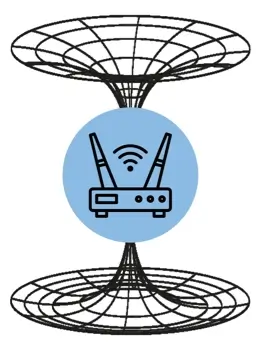What Is Blackhole Routing? | How to Stop DDoS Attacks
When you have a network as critical as your website to manage, unexpected traffic loss or network downtime isn’t ideal. One way to manage this issue is through DDoS blackhole routing. In this article, learn what blackhole routing is, how it works, and how to best utilize it.
What is blackhole routing?
Blackhole routing is a security technique that redirects malicious traffic to a "black hole" router, which is essentially a null interface that discards all incoming traffic without delivering it to the intended recipient. It mainly protects networks from DDoS (Distributed Denial of Service) attacks.
The main intention of a DDoS attack is to deplete the availability of computational resources - like bandwidth, CPU, and RAM - to a remote target so that the service is out of bounds for legitimate users. Blackholing helps keep the network safe by stopping the attack from causing too much trouble.
However, using blackhole routing without specific rules can cause problems. The technique blocks both the bad and the good traffic that real users need. This means that even people who want to visit the website might need help accessing it.
For example, websites that use connection-based protocols like Transmission Control Protocol (TCP) notify users if data drops to let them know something went wrong. On the other hand, connectionless protocols like User Datagram Protocol (UDP) do not send any alerts, so the data vanishes without a trace.
Many organizations choose blackhole routing because it is a straightforward method for combating attacks against large networks. While blackhole routing is an effective solution, the process isn't perfect. Attackers can sometimes still achieve their goal of disrupting targeted services.
Blackhole routing is helpful in many situations. It is beneficial when a small site that is part of a more extensive network is under attack. In this case, blackholing the traffic to that small part protects the rest of the network.
Network administrators who understand how blackhole routing works are better managers of their networks, albeit powerful attacks. They configure routers to redirect traffic to a null route to discard malicious activities.

What is a DDoS attack?
A DDoS attack is a type of cyberattack in which a large amount of data is sent to a specific network. Multiple computers work together to flood a target with so much traffic that the system becomes overwhelmed and stops functioning properly.
Attackers carry out DDoS attacks in different ways. Two common types are SYN floods and IP fragmentation attacks. SYN floods send many connection requests to a server, while IP fragmentation attacks break data into small pieces to confuse the system.
Network administrators should know how to spot a DDoS attack. They need to monitor the network traffic and look for unusual patterns, like a sudden increase in requests from one IP address. They also check what devices are accessing their websites to identify suspicious activity.
DDoS attacks can be very harmful to organizations. They can render the company's website unavailable or disrupt essential business operations.
Since DDoS attacks can be hard to detect, companies should be proactive. This means using tools, often cloud-based, to measure and respond to any damage caused by an attack.
How blackholing DDoS works
DDoS blackholing works by dropping unwanted traffic in a black hole. Incoming packets targeted at a specific IP address are discarded at the routing level.
Blackhole routing uses a router’s ability to manage traffic to block data packets trying to reach certain unwanted websites. This is made possible by sending contagious traffic to a "black hole," where it gets lost and never reaches its destination.
DDoS blackhole routing is cheaper than other methods, such as Access Control Lists (ACLs), but it needs more power from the router to handle the blocking. Nevertheless, it comes in handy for specific situations where other methods might not work.
To set up blackhole routing, you must work with your Internet service provider (ISP) to establish a connection called BGP peering. Next, you must set up fixed routes in your network to direct the unwanted traffic to a specific address.
After that, your router sends a signal to the BGP community, which tells the network to start blackholing the bad traffic.
Implementing DDOS blackhole routing
A large number of ISPs use blackhole routers to prevent malicious DDoS traffic from reaching its destination IP addresses. Several ways to implement blackholing include BGP blackholes, blocklists for spam filtering, and discarding IP packets targeting specific addresses.
BGP blackholing
BGP blackholing uses a protocol called BGP (Border Gateway Protocol) to help guide traffic. When a DDoS attack targets a specific IP address, network engineers can tell other routers to send the traffic to a "null route" or a dead end. That is, the traffic is automatically discarded before it reaches the victim's server.
Blocklists for spam filtering
Blocklists serve as lists of IP addresses known to send spam. When a server gets a request from an IP address on the list, it can choose to put it in quarantine for review. Blocklists can be helpful to stop spam emails before they cause problems.
Static blackhole routing
Static blackhole routing means network admins manually set up specific routes on routers to drop traffic coming from suspicious IP addresses. For instance, if an attacker’s IP is known to be malicious, the router will simply discard any traffic coming from that IP before it can reach a server.
Remote triggered blackhole filtering (RTBH)
RTBH is a more advanced technique that uses BGP to block traffic more precisely. With RTBH, administrators can block only certain kinds of traffic based on its destination - like targeting only one computer or a small group of computers on the network. This method allows the network to stay functional for other parts while still protecting the most vulnerable parts.
Flowspec BGP blackhole routing
This technique builds on BGP but provides even more control over which traffic to block. Flowspec allows ISPs to specify additional details, like the type of traffic or the size of the attack, making it easier to target harmful traffic while letting safe traffic flow.
Destination-based IP filtering
Destination-based filtering blocks unwanted traffic from reaching a specific destination on a network. A single router, or all routers in a network, can do this. It’s a simple way to prevent certain types of traffic from reaching the servers based on the destination IP. It diverts attacks aiming at specific targets, like one website or server.
Benefits of blackhole routing
DDoS blackhole routing is used in organizations to handle harmful traffic on a network. All the malicious traffic, like that from a DDoS attack, gets sent to a black hole, where it becomes useless. Here’s how blackhole routing can be useful.
- Protects your network from cyberattacks. When a network is under attack, such as during a DDoS attack, blackhole routing directs all the malicious traffic to a specific place. It helps stop the attack from reaching your systems, which can prevent downtime. It’s important to note that blackholing can block legitimate traffic, so it’s not always perfect.
- Improves network security. Blackhole routing keeps your network safer by automatically stopping bad traffic before it enters your system. You reduce the risk of an overwhelmed network.
- Trigger router method. This method involves a router sending a signal to advertise blackhole routes. It directs malicious traffic to a path that leads nowhere.
- Static route method. This method establishes a fixed route that sends harmful traffic to a "null" destination, discarding it instantly.
- Blackhole routing helps in risk management. Before using blackhole routing, network managers usually perform a risk assessment. They test the network to find any weak points that an attack could target. Once managers understand the risks, they set up blackhole routing to block traffic that could harm the network.
Limitations of blackhole routing
Blackhole routing blocks good traffic. Use it cautiously and only as a last resort if other mitigation techniques aren’t working.
Consider the following drawbacks and limitations:
- The possibility of false positives and false negatives. A false positive happens when the system mistakenly marks regular, good traffic as bad and sends it to the black hole. A false negative occurs when the system fails to block bad traffic, allowing harmful data to sneak through.
- It causes problems for regular traffic. If good traffic gets caught in the black hole, it can block users from accessing websites. It is likely to stop real users from doing what they need online.
- Evolving DDoS attack techniques are constantly changing. Attackers are always coming up with new ways to trick defenses like blackhole routing. For example, they may use botnets or amplification attacks. Users can’t tell the difference between malicious and legitimate traffic.
Applications and use cases of blackhole routing
DDoS black hole routing is used in computer networking to protect against threats. It works in various scenarios, from improving network performance to enhancing security.
In data centers and cloud computing environments, we use blackhole routing to prevent network congestion. These environments process volumes of data, and the system can only become reliable with effective traffic control. Diverting unnecessary traffic to a black hole ensures legitimate data flow remains uninterrupted.
Another use is in IoT networks and edge computing. In these networks, devices spread out over broad areas to generate vast traffic. When excessive traffic threatens to overwhelm the system, black hole routing quickly redirects it to maintain the integrity of the network.
The technique is essential in security applications, particularly for protecting against DDoS attacks. During a DDoS attack, a network can become flooded with bad traffic. What black hole routing does is send the traffic to a dead end.
Additionally, it helps with intrusion prevention, intending to reroute data so it doesn't enter the network in the first place.
Frequently asked questions
Can blackhole routing be customized for different network sizes?
Yes, you can tailor blackhole routing to fit the needs of different network sizes. Network managers can adjust it to provide the right level of security and traffic management.
What is the difference between blackholing vs. sinkholing?
Both are security strategies used to mitigate DDoS attacks, but they work differently. Blackholing sends all traffic to a null route, while sinkholing redirects traffic to a controlled IP, allowing legitimate traffic.
What is a null route?
It is a network route that goes nowhere, and the act of using null routes is called blackhole filtering.

